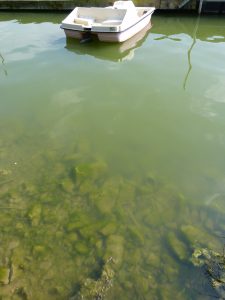
CHAMPAIGN, IL — Yesterday’s release of the Nutrient Loss Reduction Strategy by the Illinois Environmental Protection Agency and Department of Agriculture importantly recognizes one of the state’s most serious water pollution problems: Nitrogen and phosphorus pollution from farms and sewage treatment plants harming Illinois waters and contributing to the dead zone in the Gulf of Mexico. However, environmental organizations say the proposed strategy falls short of laying out needed targets and programs to resolve this critical water quality issue.
The Mississippi River/Gulf of Mexico Watershed Nutrient Task Force (led by the U.S. Environmental Protection Agency and including the Illinois Department of Agriculture) asked Illinois and other Mississippi River Basin states to tackle the problem by developing strategies to reduce the amount of phosphorus and nitrogen flowing out of rivers from each state. The science suggests that at least a 45% reduction is needed to address Illinois’ contribution to the nutrient pollution of the Gulf of Mexico, and much deeper reductions are needed to resolve nutrient problems in many rivers and lakes within Illinois.
If the nutrient reduction strategies are to work, they must contain effective limits on the amount of nitrogen and phosphorus that can be discharged into lakes and streams. While the Illinois strategy describes many good principles and options for reducing nutrient pollution, it primarily relies on voluntary actions with no enforceable benchmarks.
“The Illinois government needs to insist that those causing the problem take action in a timely manner so that this decades-old problem can finally be resolved,” said Stacy James, a water resources scientist at Prairie Rivers Network, which along with the Environmental Law & Policy Center (ELPC) and the Sierra Club is calling for stricter policies.
Illinois’ lakes and streams are filled with nuisance algae that thrive off of nitrogen and phosphorus and algal blooms ruin swimming beaches and boating areas as well as the natural beauty of open water. Some algal blooms produce toxins that can make people and animals sick. Nutrient-caused overgrowth of algae and aquatic plants suck oxygen out of the water, harming fish and other aquatic life and sometimes causing fish kills. Nitrogen and phosphorus pollution from Illinois and other Mississippi River Basin states also causes the Gulf of Mexico Dead Zone, an area as large as the state of Massachusetts where oxygen levels are depleted.
“Nutrient pollution is Illinois’ most widespread water quality problem, and the release of this draft Strategy is an important step toward solutions that will protect our drinking water and wildlife,” said Dr. Cindy Skrukrud, Clean Water Advocate for the Sierra Club, Illinois Chapter. “We are pleased that everyone agrees that overloading our waters with nutrients is a major problem. We will be reviewing this draft Strategy and offering suggestions for strong, specific actions we can take to protect our waters and the health of Illinois families and wildlife.”
In early August, Toledo, Ohio went without drinking water for several days because it was contaminated by toxins produced by algae in Lake Erie. The incident was attributed to farm runoff containing high amounts of phosphorus. Farm runoff is also a problem in Illinois, and has been linked to water pollution problems in the lakes that provide drinking water to Springfield, Decatur, Bloomington and Danville, among others. Almost half the phosphorus pollution is discharged from wastewater treatment facilities while an equal amount comes from runoff from agricultural land. In contrast, 80% of the nitrogen pollution is from agricultural runoff, and the remaining 20% is from wastewater discharges and urban runoff.
The proposed state strategy will not be effective because it does not outline specific steps to be taken that will achieve a stated agricultural pollution reduction goal. Instead, the strategy is too reliant on voluntary actions, outreach, and existing, underfunded programs. This approach will only maintain the status quo which led to the pollution problem to begin with. There are clear steps the state could take to reduce water pollution. For example, the state could limit the method or timing of fertilizer application at farms. Studies have demonstrated that more than 15% of fall-applied fertilizer can be lost before a crop is planted in the spring.
“The Illinois strategy does not lay out a real plan for definitive action,” ELPC Staff Attorney Jessica Dexter said. “If Illinois does not get serious about nutrient pollution, the state’s existing problem will go on and Illinois may wind up like Ohio where drinking water supplies and key recreational lakes have been ruined by harmful algal blooms.”







